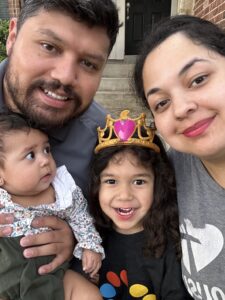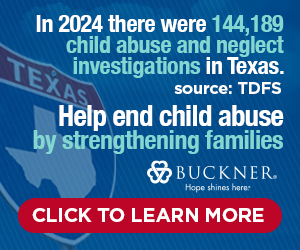A baby survived the journey to the other side of the river. This baby boy would be raised among many who accepted him, as long as he did not mention how he got here. He was raised among those who made his parents work tirelessly and hoarded their privilege and freedoms.
It is not Moses I am writing about, but my brother-in-law Gama. He entered this country through the Rio Grande at just 9 months old. He was brought to the United States by his parents—law-abiding, God-fearing people who chose to risk their lives so he would be raised in a place much safer and more promising.
The United States is the only home Gama has ever known. It’s where he was raised, educated and met his wife, my sister.
Gama is one of the greatest blessings to our family. He works for a nonprofit organization that shelters and cares for children. My favorite role of Gama’s is father to my two nieces. He is a faithful, involved and loving father.
Because Gama entered through the river without authorization, there was no pathway or “line” for him to become a U.S. resident, much less a U.S. citizen. Although he was raised and educated in the United States, he was not authorized to work. He was a “Dreamer.”
“Dreamer” is a common reference to the DREAM Act not yet passed by Congress.
For decades, any attempt to pass laws in Congress to protect young people like Gama continually failed. In 2012, President Obama issued an executive order—Deferred Action for Childhood Arrivals, or DACA.
A Catch-22
Gama, a young “Dreamer,” met the requirements to qualify for DACA. With DACA, he could now pay for and finish college.
When Gama and my sister married, our family assumed he now had a pathway to citizenship. We were wrong.
Sign up for our weekly edition and get all our headlines in your inbox on Thursdays
According to the Illegal Immigration Reform and Immigrant Responsibility Act of 1996, because Gama entered the country without inspection as a baby, he would need to return to the country of his birth to apply for an immigrant visa before his wife would be permitted to petition for his green card.

But Gama then would face a 1996 law banning reentry for 10 years for anyone who spent more than six months without legal status in the United States, which was the case for Gama as a child, before DACA.
This law is not widely known or understood, but many “Dreamers” have been asked to jump this highly unjust hurdle on their pathway to citizenship.
Gama had one other option. He could apply for parole.
This special “permission” would allow someone with DACA status to leave the country for either employment or humanitarian reasons, and then reenter through an authorized process to be considered eligible for citizenship.
Unfortunately, Gama did not qualify for either of the restrictions around parole. Additionally, the Trump administration halted all paroles.
Difficult choices
Gama’s choices were: (A) remain in the United States and continue to renew his DACA authorization every two years for $495 and hope DACA remained a legal option, (B) qualify for employment or humanitarian parole, or (C) go to his country of origin and wait out the 10-year period without any certainty of ever being reunited with his wife.
So, for five years of their marriage, Gama chose option A and benefitted from DACA.
Then, in 2021, Gama’s grandfather passed away. Because the Biden administration reinstated the parole system, Gama now could seek humanitarian parole to attend the funeral in his birth country.
The parole approval process can take months, yet Gama was privileged to receive it in just a few days. While this was a difficult time of loss for the family, it also was a time of hope. Gama now had credible reason to leave the United States, reenter properly and adjust his immigration status. But there was much fear and trembling, as nothing was guaranteed.
Although he was granted parole, his reentry to the United States would rest on the discretion of a border patrol or homeland security officer. He still was in danger of being separated from his family and the country he calls home.
Upon his return to the Houston airport, our family waited for hours to learn if he was granted authorization to reenter. These hours felt like an eternity. But we got the much-anticipated call. He was authorized to return home. My baby niece’s father was coming home! No words can describe the tears, shouts of joy and praise our family experienced.
Becoming a resident
Finally, the journey of becoming a U.S. resident could begin. But the next step required significant funding and time. It took them months to save the thousands of dollars for the immigration process and lawyer, and then they simply had to wait for the green card.
A year passed, the green card hadn’t arrived, and Gama’s DACA was about to expire. They could not risk him losing his job if he suddenly was without work authorization. So, Gama had to spend more money to renew his DACA.
While waiting for the green card, my sister became pregnant with her second daughter. It was a high-risk pregnancy. They lived paycheck to paycheck as all their savings went toward both immigration processes.
My niece was born premature and stayed in the NICU for weeks. Their stress continued to build because of difficulty securing childcare so they could continue working. Meanwhile, the medical bills piled up.
My sister, a U.S. citizen, was working only part-time. Because Gama was not a U.S. resident or citizen and had a pending immigration process, they could not seek government assistance to care for my sister or the baby. Doing so could mean he would not qualify to become a resident.
In August 2023, my sister’s family received the most liberating mail they ever could receive—Gama’s green card. Finally, Gama now truly could call the United States his home.
Protect ‘Dreamers’
Unfortunately, not all “Dreamers” have the same pathways—or any—eventually to become U.S. citizens. For more than 20 years, legislative action in Congress has failed to pass.
On Sept. 13, 2023, U.S. District Judge Andrew S. Hanen of Texas ruled the Biden administration’s ruling codifying DACA “is not lawful, bringing DACA a step closer to its potential end.”
An estimated 600,000 “Dreamers” are at risk of losing protection under DACA. While not all DACA recipients are of Latino heritage, the majority are, and the best way to honor and celebrate Hispanic Heritage Month is by advocating that Congress pass legislation to protect “Dreamers” and those who do not benefit from DACA.
One element that separates Gama’s story from baby Moses’ story is the figure of Pharaoh’s daughter. Pharaoh’s daughter took a risk by seeing the humanity and potential in a Hebrew child and advocated on his behalf.
As Zach Lambert said during Fellowship Southwest’s recent Compassion & Justice Conference, “[We need to] be like Pharaoh’s daughter who, though raised to be xenophobic and privileged in her identity, saved the Hebrew boy.”
Gama’s fellow “Dreamers” need all of us to shed our xenophobia and use our voices and privilege on their behalf.
















We seek to connect God’s story and God’s people around the world. To learn more about God’s story, click here.
Send comments and feedback to Eric Black, our editor. For comments to be published, please specify “letter to the editor.” Maximum length for publication is 300 words.